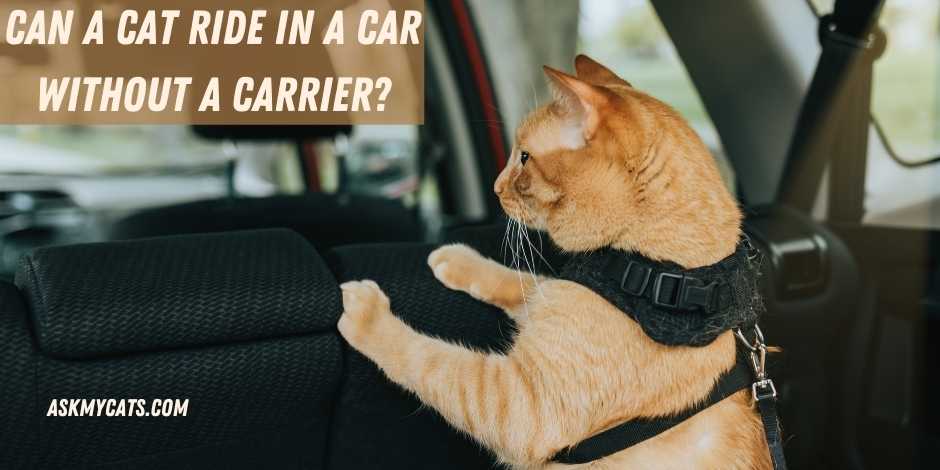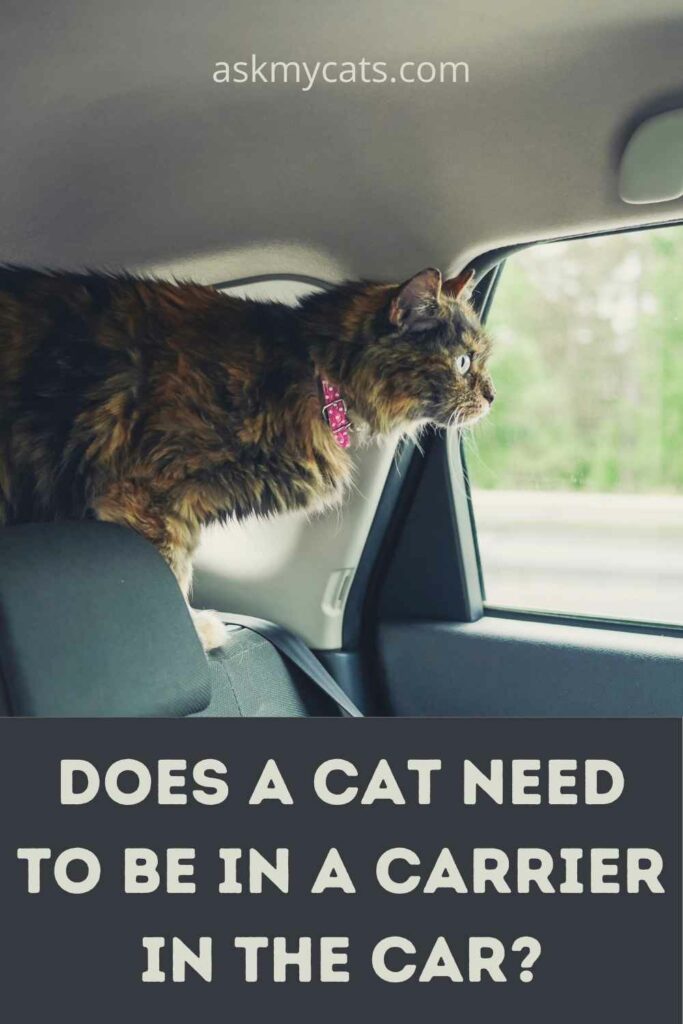Your cat, like any other family member, deserves to be loved and cared for. This, of course, entails routine medical examinations as well as transportation.
If you’re relocating, you’ll need to make specific preparations for your cat’s transportation. Remember that they have more delicate personalities than your human family members.
Yes, a cat can ride in a car without a carrier if proper measures are taken for the safety and health of your pet cat.
Man-made vehicles will make your cat feel uneasy since cats prefer the natural and familiar. Cats despise traveling, and it is often a cause of anxiety for them.
This is, of course, the rationale for the specific arrangements described before. We’ll look at a few other ways to carry a cat without using a cat carrier in this article.


Give Your Cat the Perfect Day
Get the Free Ebook!
Can A Cat Ride In A Car Without A Carrier?
Yes, a cat can ride in a car without a carrier as long as it is adequately secured and does not impose any restrictions on the driver.
Every state, however, has its own rules regarding distracted driving with cats on one’s lap or loose in the vehicle. To minimize pet-related distractions, several states now mandate that their dog or cat be properly confined.
Before you start traveling with a cat or looking for a new cat carrier, make sure you do your homework.
I’m going to tell you what I’ve discovered about riding in a vehicle with a cat on your lap or loose in the vehicle. Then we’ll look at how to travel securely in your automobile so that you and your passenger reach your destination safely.
If your cat spends most of its time indoors, a vehicle journey or a road trip may not be warmly received. She may be anxious, irritable, and have a terrible case of motion sickness. It’s possible that your cat is drooling in the car as well.
Also, if you haven’t yet trained your cat to use a carrier, she may not be accustomed to it. The easiest way to get a very hostile cat into the carrier is to have a family member or friend accompany you and carry the cat or have her sit on their lap.
Why shouldn’t your cat do the same? It’s normal protocol for everyone to buckle up in a car, so why shouldn’t your cat? Your cat, like everyone else, should receive the same level of care as other passengers, and she should be appropriately confined as well.
If there are any unexpected movements or an accident, your cat’s life may be spared if it is correctly confined. If the passenger seat has an airbag, the cat should be in the backseat; if the passenger seat does not have an airbag, she should be in the front passenger seat, presuming she is the sole passenger in the vehicle.
Cats are often frightened, and unexpected movements and noises might cause them to jump out of their chairs. When a cat is scared, it usually jumps off and begins hissing or running about. Her actions might be highly distracting to the driver, as well as to you.
In addition, your cat may jump on your lap or possibly scratch you. Because your cat may easily roam inside the car if she is not securely confined in a carrier or a cat harness, all of these scenarios are likely to occur.
Interesting Read: Cat Pee In Car: How To Get Rid Of Cat Pee Smell In Car?
Does A Cat Need To Be In A Carrier In The Car?
A carrier is very much necessary in the car to ensure the safe transportation of your pet cat.

Many novice cat owners overlook the need of purchasing a cat carrier. They do not believe it is a required expenditure.
Cats dislike carriers, which is one of the factors that led them to this conclusion. In a carrier, they tend to be anxious.
Getting your cat into a carrier also appears to be a lot of labor. So, at first look, it may appear like taking your cat on a journey without a carrier is the easiest option. But it’s completely incorrect!
The first thing you should know is that a cat carrier will keep your cat safe from damage from the outside world.
It’s a must if you want to keep your cat secure. I can’t tell you how many times I’ve heard that a cat escaped from a vet’s office. Ninety percent of these incidents are caused by the lack of a carrier.
Your cat cannot run away or escape from a carrier. As a result, there is no chance of your cat escaping unattended on a trip. Furthermore, most veterinarians these days dislike it when you bring the cat in without a suitable carrier.
Yes, it takes some time to get your cat acclimated to her carrier and friendly with it. But believe me when I say that the effort is well worth it. Isn’t it true that our primary responsibility is to keep our pets safe?
There’s no such thing as being too safe. Even the calmest cat has gone wild on a vehicle journey, according to legend.
If you don’t have a carrier for your cat in the automobile, it may be quite dangerous. If you can’t afford a good carrier, get something else like a sports bag or a basket.
A harness and leash can also be used to secure the cat to a seat.
You don’t want your cat to go beneath your feet while you’re driving since this might result in a catastrophic accident.
If you don’t have a car, it’s best to take public transit with your cat when traveling to the vet or anywhere else.
However, keep in mind that most modes of transportation require you to travel your cat in some form of container.
So, before getting on the ride, double-check with the transit system. You may transport your cat in a basket or sports bag if they require a carrier.
When traveling with your cat on public transit, it is not advised that you wear a harness.
Also, before embarking on a long road trip, remember to take short journeys with your cat on public transportation.
You can also get a lift from a buddy. I’m sure it won’t bother your pal!
What Can You Use Instead Of A Cat Carrier?
You can use any of the things listed below instead of a carrier:

1. Sports Bag
The first thing you should think about is your safety.
Traveling with your cat without a carrier is quite dangerous. If you simply take her in your arm, she may become agitated and flee.
It’s difficult to keep a nervous cat under control. And if she manages to get away, you’ll be in for a nightmare trying to track her down. So, my first recommendation is to use a sports backpack instead of a cat carrier.
A sports bag is a particularly designed bag for transporting clothing and other items from a gym or sports club. The majority of the sports bag is constructed of nylon, which is quite robust and has tiny openings on the sides. These sports bags are capable of transporting your cat safely.
The tiny openings along the side should provide adequate ventilation. Make sure your sports bag has some sort of ventilation, such as holes or mesh sides. It is really crucial. Your cat may suffocate or possibly become ill if there isn’t adequate airflow.
Get a sports bag with a sturdy flat bottom as well. These sports bags are ideal for transporting cats since they are not unpleasant.
A warm blanket, toys, and other items can be placed inside the bag to make it more pleasant for your cat.
2. Cat Harness
Taking your cat for a walk typically necessitates the usage of a cat harness. If you’re going out with your cat and don’t have a carrier, it may be a really handy item. It significantly improves your cat’s safety.
Harnesses for dogs and cats are not the same. Use a harness that is made particularly for cats. Otherwise, your cat may be harmed.
If this is your cat’s first time wearing a harness, he or she may get apprehensive. You must treat her with extreme gentleness. Allow her to sniff and investigate the harness.
Then gently slip the harness inside your cat’s body and fasten it. Check to see if the harness is too tight or too loose. If your cat resists, try again when she has calmed down.
You can also get assistance from a second-hand source! Do not attach the leash immediately after your cat has worn the harness for the first time.
Allow her some time to adjust to the harness. Of course, keep an eye on your cat at all times. After some time has passed and she appears to be at ease with the harness, connect the leash.
Before embarking on a long vehicle journey, have your cat practice wearing the harness for brief periods of time. Take your cat outside for a half-hour stroll in the park.
Your cat will quickly become used to the harness with frequent practice. She should be ready for a lengthy vehicle journey in about a month or two.
If you don’t rehearse with your cat first, utilizing the harness for the first time during the voyage may make her frightened and sick. As a result, don’t miss this step. You may also use a harness to transport your cat to the veterinarian.
3. Cheap Basket
If your cat is calm, you should be able to carry her in a basket or bed. This choice is only appropriate if your cat has a calm demeanor. If you’re not sure about your cat’s behavior, don’t take the chance. If she becomes agitated, she may jump out of the basket and flee.
If she becomes worried or terrified, even the calmest and quietest cat will want to flee. As a result, proceed with caution when using this approach.
Interesting Read: Can You Travel With A Pregnant Cat? Is It Safe?
Can You Put A Cat In A Pillowcase?
A cat can be transported easily by using a pillowcase cat carrier.
To transport your cat, use a pillowcase. Just make sure it’s brand new and doesn’t have any holes. To protect your cat from escaping, place it inside and secure the top with a shoelace. The pillowcase allows the cat to breathe but prevents it from seeing.
Make sure you’re using a pillowcase that’s big enough for your cat to fit in. I would suggest purchasing a new one solely for the purpose of bringing your cat to the veterinarian.
I understand that carrying a cat in a pillowcase may sound harsh, but don’t worry; there are numerous more choices available.
Can Cats Breathe In A Pillowcase?
Cats would be able to breathe in a pillowcase if it is not too tight or suffocating. The pillowcase should also not be fully covered and provided with some breathing spaces.

When it’s time to put the cat in the pillowcase, simply leave it open on the floor and place the cat inside casually. Pull it up and knot it up fast.
Make sure the knot is securely fastened. I generally knot it twice.
The vet explained to me that the pillow case helps the cat to breathe while also preventing it from seeing where it is going.
When cats see a crate outside, they are usually agitated. You can securely carry the cat in your arms as usual. When you hold the cat, it calms down.
Also, when the cat is being examined by the veterinarian, it is typically allowed to remain in the open case. It will have the security of the case to stay in if it grows agitated while waiting.
Can I Use A Duffel Bag As A Cat Carrier?
To transport your cat to and from the veterinarian, you can use a duffel bag or backpack.
Use a bag that allows for lots of airflows. If your cat urinates in it, it will be easy to clean because duffel bags are machine washable.
If you must travel your cat, we cannot emphasize enough the necessity of utilizing a conventional cat carrier. These carriers were created particularly for transporting cats. In fact, most veterinarians have stringent regulation that prohibits them from seeing a cat unless it is in a suitable carrier.
In the unfortunate case that you do not have a carrier, there are a variety of options for carrying your cat. Keep in mind, though, that cats do not travel well by nature. They like to be in a stable and familiar environment.
Make sure the bag has a firm bottom so it doesn’t collapse with the weight of your cat when you pick it up. To keep them safe inside, the bag should be free of holes and have a functional zipper.
Interesting Read: Why Do Cats Pant in the Car? How To Travel With Your Cat Safely?
Frequently Asked Questions
Can you drive with a cat loose in the car?
It is not safe to drive with your cat running about freely in your vehicle. Your cat may become startled and dart under the brake or accelerator pedal, perhaps causing an accident. Having a cat bounce about the vehicle is also a potential distraction.
How to Calm Down a Cat in the Car?
Having a decent cat carrier is the first step. This should be a sturdy box that can contain your cat while also keeping them safe and protected. The most prevalent carriers are hard or soft. The sort of carrier that is appropriate for a cat is frequently determined by its personality.
How to Travel Long Distances with a Cat?
Choose a carrier that is well-ventilated and large enough for your cat to stand up, walk about, and stretch out in. Unless the cat is leashed, don’t allow it out of the cage until you’ve arrived at your destination. If you’re flying, be sure any crate you use is USDA-approved for shipment.
Final Words
Taking your cat on a vehicle journey may be a highly enriching experience for her since it allows her to see new sights, sounds, smells, and places. She should be carried or harnessed to protect herself from damage and injury.
Feel free to ask your questions in the comments section below!
References
- https://www.pethub.com/article/pet-care/tips-on-how-to-move-or-travel-with-your-cat
- https://www.greencrossvets.com.au/pet-library/articles-of-interest/10-tips-for-cat-transporting/
- https://www.thesprucepets.com/help-cats-enjoy-car-travel-553891
- https://www.allfelinehospital.com/traveling-with-your-cat.pml
